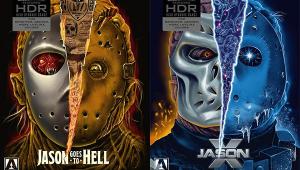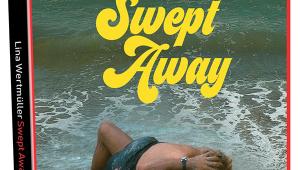2001: A Space Odyssey: Where the Silences Deafen
"This time tomorrow, where will we be / on a spaceship somewhere, sailing across an empty sea."---Ray Davies, The Kinks, 1970
In 1968, when Stanley Kubrick's masterful adaptation of Arthur C. Clarke's short story "The Sentinel" hit the big screen, 2001 was 33 years away---a lifetime for a 21-year-old. Where would we be? I wondered (not yet having heard Ray Davies' song) as I drove with some college buddies to see 2001: A Space Odyssey in Cinerama. I'd made an 8-track tape of the fanfare to Strauss' Also sprach Zarathustra from the DGG original because MGM's LP soundtrack version sounded so awful, and we played it repeatedly during the hour drive---a pleasant diversion while waiting for the chemical enhancements to kick in.
The sound was awesome, actually, because I'd outfitted my Firebird 400 with four Altec-Lansing 405As---heavyweight 4" monsters that were far superior to anything then available in car audio. We hit the theater well equipped, we thought, but no one was prepared for the sonic and visual feast Kubrick served up. Nothing like it had ever been seen before on the big screen. The music, featuring both the comfortably familiar Blue Danube by Johann Strauss and György Ligeti's disturbing, discordant choral works, was yet another sensual jolt.
As the opening scenes unfurled, one could only wonder where Kubrick and Clarke were heading. When the monolith appeared for the first time, wonderment gave way to confusion. And when the bone/weapon hurled in the air was jump-cut to a space shuttle, confusion gave way to submission. Kubrick and Clarke were asking us to evolve, in a few hours, beyond linear thinking, past the limitations of our three-dimensional perceptions, to the fourth dimension, experienced by humankind as the illusion of passing time.
Thirty-one years later, amid an upsurge in dogmatic religious fundamentalism and superstition, it seems as if we've failed to scale the lofty intellectual heights Kubrick and Clarke hoped their movie would help inspire us to climb. However, viewing this DVD demonstrates that Kubrick and his team got the future more right than wrong. In fact, they probably influenced it as much as they predicted it. (But how could they know that, in the meantime, Pan Am would go from the premier world airline to bankruptcy?)
Except for a few grainy television transmissions, Kubrick wisely avoids showing us life on Earth in 2001. But his vision of an antiseptic, plastic, fluorescent, high-tech future, and the pivotal role the computer plays in it (and the creepy relationship developed between man and machine), were right on course, if a bit ahead of their time. HAL---the talking, "thinking" computer---is a much higher probability today than it was then.
Time has been more than kind to the technical advancements shown in the film. In fact, it's been downright flattering. Dozens of small details shown in the movie, fantasies in 1968, have become reality. For example, the crew tests the microscopic printed circuit boards in the "failed" AE 35 antenna unit using a logic probe, which automatically displays close-ups of the circuitry on a computer screen. Young viewers today will take that bit of technical business for granted, but for those of us seeing it for the first time in 1968---back when vacuum-tube testers could be found in every drug and department store and solid-state audio gear was just becoming a reality for consumers---the scene reeked of science fiction.
Perhaps a generation raised on a steady diet of Star Wars and Close Encounters will be unimpressed with this movie's special visual effects. But for those of us who encountered 2001: A Space Odyssey in 1968, and whose concept of a space vehicle's form was a straight-sided variation on Hitler's V2 rocket, the bizarre shapes Kubrick put on the screen that year were nothing short of mind-shattering. The psychedelic rush that ends the film, as much fun as it is, is nothing more than LSD-laced icing on the cake.
While 2001 has not been restored, the transfer master was evidently in relatively good shape. I noted only a few small scratches and bits of schmutz. For the most part, the picture is crisp and clear, with rich, velvety blacks and well-saturated colors. My biggest complaint is a flickering on the top of the letterboxed screen for the first few "reels." Otherwise, Kubrick's vision---right down to the mysterious atmospheric music that was played in theaters before the film started and during the intermission---is brought to the small screen in fine fashion.
Special features include the original theatrical trailers and a fascinating, highly informative speech (mislabeled an "interview") given by Arthur C. Clarke at a press briefing before the film's premiere.
The discrete 5.1-channel sound, probably taken from the 6-track 70 mm mag-stripe mix, is dated, being dynamically compressed and rolled-off on top. No matter: The startling simplicity, clarity, and originality of the music and sound effects continue to impress. The film's audacious silences---placed precisely where lesser filmmakers would have piled on sound effects and dramatic music---are deafening.























































